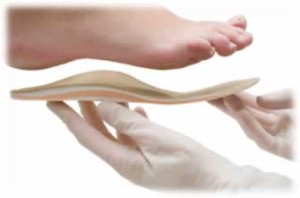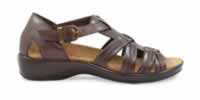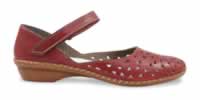Orthotic prescription
 Orthotics can play an essential role in the management of a variety of lower limb pathologies – heel spurs (plantar fasciitis), shin splints, patellofemoral pain, foot, ankle and knee arthritis and many more. Sadly, orthotics are often needlessly expensive, poorly designed or inappropriately prescribed.
Orthotics can play an essential role in the management of a variety of lower limb pathologies – heel spurs (plantar fasciitis), shin splints, patellofemoral pain, foot, ankle and knee arthritis and many more. Sadly, orthotics are often needlessly expensive, poorly designed or inappropriately prescribed.
If you are prescribed orthotics it is important to wear them in appropriate shoes. It is advised to bring your most commonly worn shoes to your consultation.
A little information about orthotics
Orthotics will be prescribed to correct the way your foot and ankle takes weight when you stand or walk. In so doing, an orthotic can be helpful in reducing stress through the foot, shin and knee. Orthotics may also be prescribed to reduce or increase the amount of work the muscles in your leg are required to do (patella-femoral syndrome, trochanteric bursitis, fat-pad impingement of the knee). Finally, orthotics may also be prescribed to stabilise and support various components of the foot and ankle (Morton’s neuroma, plantar fasciitis/heel spurs, achillis tendonitis etc). It is important that you understand why your orthotics have been prescribed as well as how often and exactly when you need to wear them. Talk to your doctor or physiotherapist if you are unsure.
Getting comfortable with your orthotics
 If you have never worn orthotics before it is important that you get use to wearing them. Eventually your orthotics should feel so comfortable that is becomes difficult for you to tell you are even wearing them. Here are some guidelines for ‘breaking-in’ your orthotics:
If you have never worn orthotics before it is important that you get use to wearing them. Eventually your orthotics should feel so comfortable that is becomes difficult for you to tell you are even wearing them. Here are some guidelines for ‘breaking-in’ your orthotics:
 Make sure you wear your orthotics in a suitable shoe – shoes that have laces or a strap on top of the foot (to hold your foot firmly down onto the orthotic) are ideal.
Make sure you wear your orthotics in a suitable shoe – shoes that have laces or a strap on top of the foot (to hold your foot firmly down onto the orthotic) are ideal.It is important to remember that just because you have been prescribed orthotics, you have not been given a life-sentence to wear unfashionable shoes.
It is also important that your shoe has some support around the heel of your foot. Unfortunately orthotics cannot be worn in thongs or open-backed sandals. If there are specific shoes you wear on a regular basis, discuss the range of orthotics that are available to accommodate different footwear – depending on the problem you have, you may be a suitable candidate for a less bulky orthotic that can be worn in most shoes including high-heels.
- Get comfortable with your orthotics slowly – most people will find it takes 1 to 2 weeks before they can wear their orthotics all day without discomfort. In the first few days you may only be able to wear them for 1 to 2 hours before your feet start to feel uncomfortable. As soon as this happens, remove your orthotics for at least a few hours or until the next day and try to wear them again.Day by day you will be able to wear them longer and longer before they start to feel uncomfortable. Once you are able to wear your orthotics without discomfort for 8 to 10 hours at a time, your doctor may want to alter them in accordance with your foot type and the problem for which you are receiving treatment.Do not persist wearing your orthotics in these early days if you start to experience ANY pain. Most people experience discomfort in the arch of their foot. This is not something that will ease or go away if you continue to wear the orthotic.
- Once your doctor has adjusted your orthotic you may find they return to feeling a little uncomfortable again. If this does occur, go back to wearing them for just a few hours at a time and gradually increase the time you are wearing them over several days.
- Make sure you are happy with your orthotics. Not only should they feel comfortable, they should alleviate the symptoms for which you sought treatment. The pre-moulded orthotic you have been prescribed can readily be adjusted and moulded to your foot. The orthotics can have a soft covering added to them and they can have additional support built-in specifically for your foot. Because they have not been cast to your foot like a hard orthotic (which cost between $400 and $500) they may need adjusting several times before you are completely satisfied. Remember, it does not cost you to come in and have your orthotics adjusted so make sure you are 100% happy.Most adjustments can be done whilst you wait. There may be a cost for the materials used to adjust your orthotic so discuss this with your doctor first.
- If you wear your orthotics daily they should easily last at least 24 months. This may be less if you are also wearing them during sport. If you are unsure whether your orthotics are still providing the right support make an appointment to speak with your doctor or physiotherapist.
- Take your orthotics with you when you purchase new shoes. Most stores will have a range of footwear that is suitable for use with an orthotic.
- Discuss how often you should be wearing your orthotic with your doctor. Most conditions will require you to be diligent with wearing your orthotics for the first 2 to 3 months (ie at least 10 to 12 hours per day). After that you may only need to wear your orthotics for sport or at work so don’t throw away your favourite sandals, thongs or high heels.
For a full list of our fees and services click here.
To make an online booking with one of our doctors click here.





